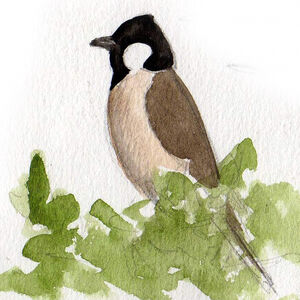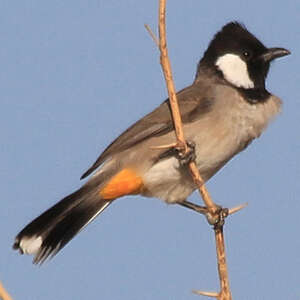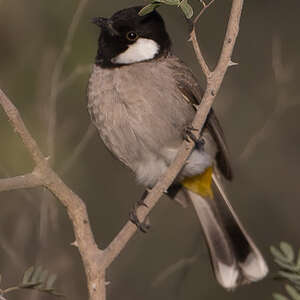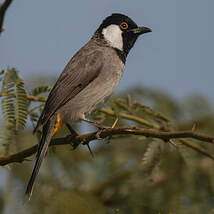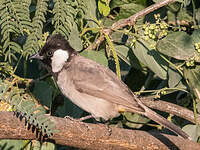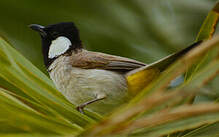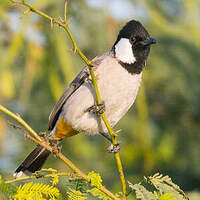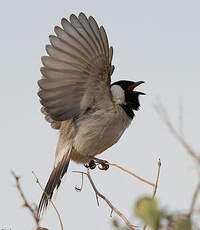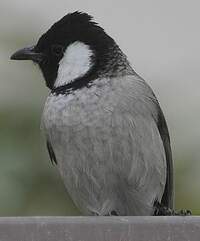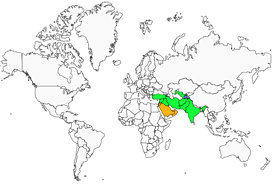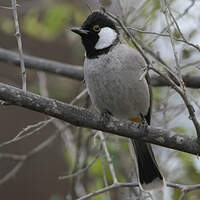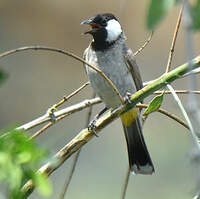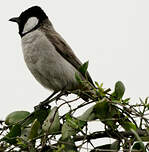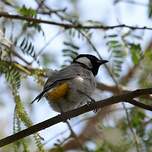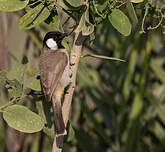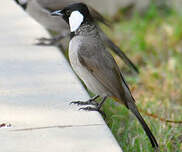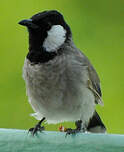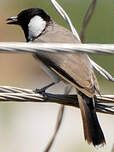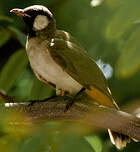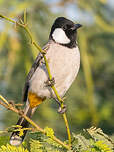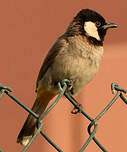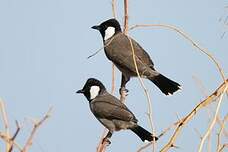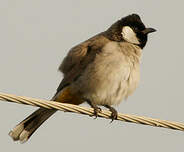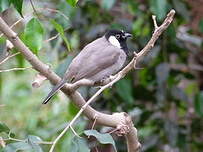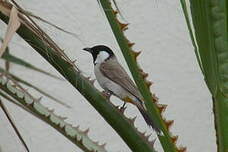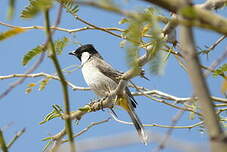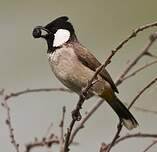White-eared Bulbul
Pycnonotus leucotis - Bulbul à oreillons blancs
Identification
The White-eared Bulbul is a bird you won't forget : its name sounds nice and is easy to remember. Its origin comes from successive translations of the Persian name Bolbol to Arabic, which was translated to English as nightingale - our own nightingale! This translation wasn't kept, but its generic name did, and 138 species of bulbuls occupy Africa and Asia! Our White-eared Bulbul is 20 cm long, its head is an unforgettable sight with its characteristic white ear-coverts, its crown, nape, throat and forehead are black. Its beak and eye are black, and the eye is surrounded by a grey eye-ring. Its mantle, wings and back are grey, the greater coverts may be faintly darker. Its breast is white and its belly is cream color, the white also covers its rump. The rectrices are grey at the base darkening almost to black, and the tail ends are white. Besides the white ear-coverts which give its name to our bulbul, a distinctive second mark is its bright golden yellow belly, which you can't miss. Its legs are dark grey ; there is no sexual dimorphism, the juvenile's head is brown instead of the adults' black, with the other colors, such as the yellow belly being much paler.
Subspecific information 2 subspecies
- Pycnonotus leucotis leucotis (s Iran, s Afghanistan, Pakistan and nw India)
- Pycnonotus leucotis mesopotamia (ne Arabia, s Iraq and sw Iran)
Foreign names
- Bulbul à oreillons blancs,
- Bulbul orejiblanco,
- bulbul-de-orelha-branca,
- Weißohrbülbül,
- fehérarcú bülbül,
- Witoorbuulbuul,
- Bulbul orecchie bianche,
- vitkindad bulbyl,
- Hvitørebylbyl,
- bylbyl bielolíci,
- bulbul bělouchý,
- Hvidøret Bulbul,
- valkokorvabulbuli,
- bulbul d'orelles blanques,
- bilbil białouchy,
- baltausu bulbulis,
- Белый ушастый бюльбюль,
- シロミミヒヨドリ,
- 白耳鹎,
- 白耳鵯,
Voice song and cries
Habitat
He prefers wooded areas, bushes but is also seen in semi-desert areas as well as near rivers or even mangroves. Proximity to humans suits him and he is seen in orchards and cultivated areas. Generally, it stays at sea level, from 2,000 m, the White-eared Bulbul takes over at altitude in Pakistan and India.
Behaviour character trait
In general, sedentary but it is known that in the north and center of Pakistan, non-breeding birds mix with sedentary populations in winter. In the North West of Pakistan, it becomes a summer resident from March to October. In the countries bordering the Persian Gulf, it arrives in September to leave in June. White-eared Bulbuls have been seen in date palm groves in Iraq and Iran, suggesting they can cross difficult regions. They occasionally gather in flocks of 20 to 30 individuals.
Dietfeeding habits
He is mainly frugivorous, it is known that he likes jujubes and seeks the nectar of Capparaceae, of which the best known variety is the caper. His diet is supplemented with many invertebrates: beetles, various insects and termites. He quickly dives to the ground to catch insects or look for seeds but he also knows how to catch his prey in flight.
Reproduction nesting
The breeding season ranges from February to September, from April to July in Iraq and from July to September in India.
Occasionally observed in groups of three birds, which suggests possible breeding in threes, though the information is still vague. The nuptial parade is characterized by the opening and flapping of the male's wings, while he displays his tailFan. The cup-shaped nest is made of twigs, roots and various vegetable fibres, at a height of one to three meters, all types of trees can accommodate the nest, eucalyptus, palms, fruit trees or large bushes. Along the Euphrates, it nests in reed beds. An opportunistic bird, it can make its nest in a rocker hole or even in a house, verandas seem to suit it! The clutch is two to four eggs and only the female incubates for 13 to 14 days in Pakistan; the period will be shorter in Iraq: 10 to 12 days. The couple feeds the chicks for about ten days and must protect their young from all predators, especially crows.Geographic range
Two subspecies are recognized, ssp mesopotamia, slightly larger with a yellowish eye-ring, is located around the Gulf of Oman and the Persian Gulf: Saudi Arabia, Iraq, Iran. The ssp leucotis is centered in northwest Afghanistan, Pakistan and northwest India. Spotting observations in Israel and Jordan have been made and are more likely due to escaped captive individuals. White-eared Bulbul is known as Bulbul à oreillons blancs in French.
Threats - protection
IUCN conservation status
concern
in the Wild
threatened
evaluated
The Indian white-throated Kingfisher (IWK) is common in all the regions where it is seen, in Pakistan, being described as the most common bird of the country! It is now competing with the Red-vented Bulbul and some hybridization is appearing. The White-eared Bulbul also seems to be favored by breeders, without, for the moment, hurting the species.
Sources of information
- IOC World Bird List (v14.1), Gill, F and D Donsker (Eds). 2024-04-18.
- A Field Guide to the Birds of the Indian Subcontinent, Krys Kazmierczak, Ber Van Perlo
- A Photographic GUIDE TO THE BIRDS OF INDIA, Bikran Grewal, Bill Harvey, Otto Pfister
- Vol. 10 - Handbook of the Birds of the World, Josep del Hoyo-Andrew Elliott-David Christie
- xeno-canto, Sharing bird sounds from around the world,
- ARKive, Christopher Parsons
- Neojohnston.org,
- Neotropical Birds Online,
- Oriental Bird Club,
- Wikipédia, Wikipedia, The Free Encyclopedia
Other sources of interest
 Specification sheet created on
30/07/2023 by Anne et Gabriel Leboff
Specification sheet created on
30/07/2023 by Anne et Gabriel LeboffTranslation by AI Oiseaux.net
published: 07-05-2013 - Updated: 20-05-2013
© 1996-2024 Oiseaux.net
- Accipitriformes
- Aegotheliformes
- Anseriformes
- Apodiformes
- Apterygiformes
- Bucerotiformes
- Caprimulgiformes
- Cariamiformes
- Casuariiformes
- Charadriiformes
- Ciconiiformes
- Coliiformes
- Columbiformes
- Coraciiformes
- Cuculiformes
- Eurypygiformes
- Falconiformes
- Galliformes
- Gaviiformes
- Gruiformes
- Leptosomiformes
- Mesitornithiformes
- Musophagiformes
- Nyctibiiformes
- Opisthocomiformes
- Otidiformes
- Passeriformes
- Pelecaniformes
- Phaethontiformes
- Phoenicopteriformes
- Piciformes
- Podargiformes
- Podicipediformes
- Procellariiformes
- Psittaciformes
- Pterocliformes
- Rheiformes
- Sphenisciformes
- Steatornithiformes
- Strigiformes
- Struthioniformes
- Suliformes
- Tinamiformes
- Trogoniformes

